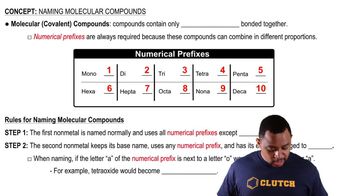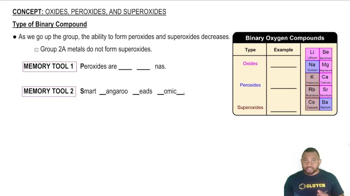Here are the essential concepts you must grasp in order to answer the question correctly.
Ionic Compounds
Ionic compounds are formed when atoms transfer electrons, resulting in the formation of charged ions. Typically, these compounds consist of a metal and a non-metal, where the metal loses electrons to become a positively charged cation, and the non-metal gains electrons to become a negatively charged anion. The electrostatic attraction between these oppositely charged ions leads to the formation of a crystalline lattice structure.
Recommended video:
Molecular Compounds
Molecular compounds are formed when two or more non-metal atoms share electrons through covalent bonds. These compounds consist of discrete molecules, where the atoms are held together by shared pairs of electrons. Unlike ionic compounds, molecular compounds generally have lower melting and boiling points and do not conduct electricity in solution.
Recommended video:
Naming Molecular Compounds
Predicting Compound Type
To predict whether a compound is ionic or molecular, one can examine the elements involved. If the compound contains a metal and a non-metal, it is likely ionic, as seen with compounds like FeCl3, which consists of iron (a metal) and chlorine (a non-metal). Conversely, if the compound consists solely of non-metals, it is typically molecular, indicating the nature of bonding and properties of the substance.
Recommended video:
 Verified step by step guidance
Verified step by step guidance


